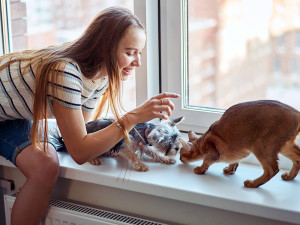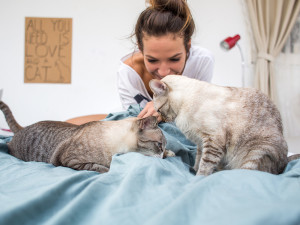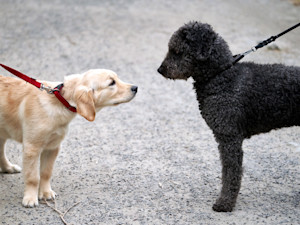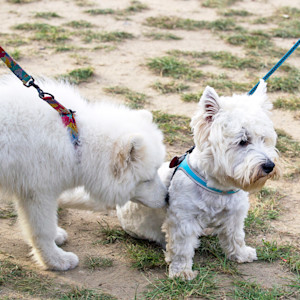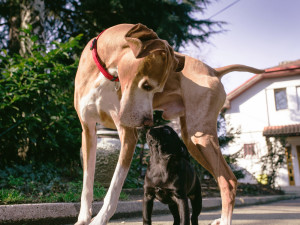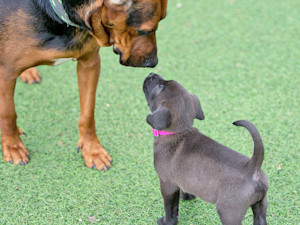How to Introduce a Scared Cat to a Dog
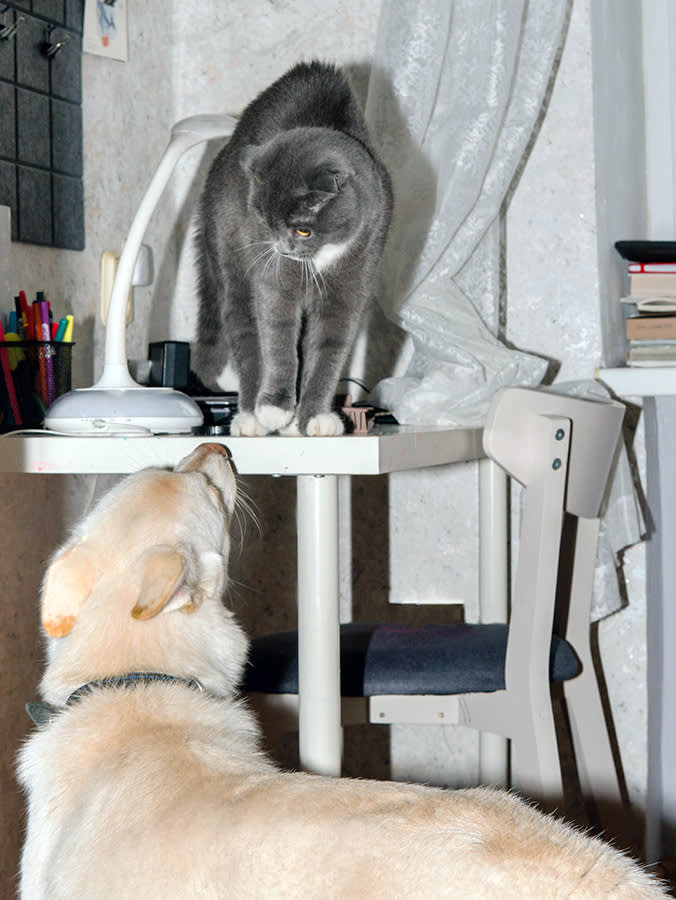
Share Article
In This Article:
How Do I Introduce a Cat to a Dog?opens in a new tab Why Are Cats Scared of Dogs?opens in a new tab How To Introduce A Scared Cat to a Dogopens in a new tab
Despite what TikTok may tell you, not every cat is best friends with the household dog. Yes, there are some kitten-puppy pairings that break the internet, but even if they’re close now, they may not have always been that way. In fact, when you introduce your cat to a new dog, it’s important to take things slow, especially if you are hoping for them to claim best friend status one day.

littleKin™ is Kinship’s home just for puppy and kitten parents. Bop over to check out expert advice, new pet tools, and special deals—all curated for your newest family member.
opens in a new tabHow do I introduce a cat to a dog?
Whether you’re bringing a new cat into a home with your dog, or vice versaopens in a new tab, a proper introduction is one of the most important things to think about. You want them to become best buddies, or at the very least, live comfortably with each other, without fear or stress.
But there’s more to it than that. In the wrong situation, cats and dogs can do real damage to each other — sometimes ending in tragedy. Let’s talk about how to get your cat and dog introductions off on the right foot … or should I say paw.
Why are cats scared of dogs?
One cat may love new dogs ,while another is so scared they lash out in defensive aggression. One dog may walk up and give a new cat a big lick. But another’s prey drive might kick in when that cat runs down the hall, meaning the cat is in real danger.
The first step in understanding how to introduce your scared cat to your dog is knowing a bit about why cats are often afraid of dogs to begin with.
Instinctual behavior
Cats are predators. But they’re also prey to many other animals. Wolves, wild dogs and even domesticated dogs can certainly be a threat to cats. And a scared cat reacting aggressively to a dog can make that dog feel they need to defend themselves.
Remember, those natural instincts can kick in at any time, for both animals. I’m very sad to say I’ve seen more than one instance of a cat being killed by dogs. The dogs were not feral or aggressive. One of them was my soul dog. She was as gentle as they come. Something just sparked that prey drive and instinct kicked in.
It can happen to anyone. Animal instinct is not something to take lightly.
Past interactions
A cat who has even one scary run-in with a dog makes a mental note that dogs can be dangerous. Your cat probably isn’t going to make a distinction between that one and your adorable new Terrier. A single interaction can impact their comfort with dogs from that point on.
Breed and personality compatibility
There are no absolutes. But some cat breeds tend to be more relaxed and comfortable in general and with other animals. Larger breeds may feel more secure around dogs because of their size.
The same is true with dogs. Some are bred specifically for their hunting instincts, which can mean a heightened prey drive. Others are bred to protect the critters on the farm and may bond with a cat. Tiny dogs may be less comfortable with cats.
At the end of the day, look at a combination of things, including (but not limited to) breed, personality, and history.
Socialization history
It’s not just about whether a cat has been around other dogs in the past. It’s how. Maybe your neighbor’s dog came overopens in a new tab, and your cat hid under the bed the whole time. Or your cat’s previous guardians thought it was fine when the dog playfully chased them under the table. When that happened, they formed negative associations with dogs right off the bat.
But a cat who was socialized to dogs in a positive way (with the choice to play or not, lots of positive reinforcement, etc.), learned that good things happen when dogs are around.
Size difference
As mentioned above, a big size difference can be a trigger. Being a seven-pound cat standing next to a 250- pound Mastiff is like you standing next to a 6,000-pound elephant. It can be intimidating, for sure.
How to introduce a scared cat to a dog
There’s really not much difference between introducing a relaxed cat and a scared cat to a dog. That’s because the key in any pet introduction is moving at their pace. Don’t push either one past their comfort zone at any point. If your cat is scared, you may just need to move a bit slower or add in a couple of baby steps to help turn the intensity down for them.
Study their body language.
Learn a little about cat and dog body language before you start, so you can catch the subtle signs of nervousness before things escalate. This is even more important if your cat is scared. The goal is to make sure they’re not nervous or stressed at all. If you see these from your cat, turn the intensity down:
Staring intensely
Dilated pupils
Unwilling to turn their back or look away from the dog
Hissing or vocalizing
Trying to look larger or smaller
Puffed fur (piloerection)
Licking the lips
Fidgeting
Tail twitching in an agitated way
Skin twitching
General nervous behavior
Prepare with treats, toys, harness and leash, and a pet gate or crate.
You’ll want to set up a barrier that your dog can’t get through. A secure pet gate can work. If your dog is crate- trained, you might use the crate. Having them on a harness and leash provides another layer of safety.
You’ll want something positive for both pets to focus on during interactions. Be aware that some cats and dogs can resource guard, getting aggressive if another animal is around when they’re eating. Also, be careful using toys. Playing with the dog could intimidate the cat. Playing with the catopens in a new tab could stimulate the dog. Know your pets and watch their body language.
Keep them separate at first.
Start with your cat separated from your dog. If the cat is the new family member, give them time to get used to their new home before you start the introduction. Let them explore, as they’re ready, while your dog is in another area. When they’re relaxed throughout the home, you can start your intro.
Allow them to get used to each other’s smells.
If your cat and dog hang out in the same areas (rotating in at different times), you can leave treats where they were before you rotated them. For example, when your dog goes from the living room to the backyard, and your cat goes into the living room, leave treats where the dog had been resting in the living room. When the cat goes into the bedroom and the dog comes back to the living room, leave treats where the cat had been hanging out.
If you aren’t rotating them, you can use two cloths or blankets that they’ve laid on. Just move them into the other pet’s area once a day, with treats on top. This helps build positive associations with each other’s scent.
Let them see each other.
When they’re doing really well with scent — no signs of nervousness or overexcitementopens in a new tab — move on to doing very short sessions at your gate (or with your dog in the crate if they’re comfortable there).
Put lots of space between them. They should be far enough apart to feel completely relaxed and happy to focus on treats, pets, or whatever positive things you’re using. If they can’t relax at any distance, you’ll need to turn the intensity down. Start with the gate covered so they can’t see each other. Do sessions like this for a while. Then slowly uncover the gate over multiple sessions.
As they’re ready, they can start moving closer to the gate, and you can gradually make the sessions longer. But you need to be right there, trying to keep them focused on their positive things and not on each other. Don’t let them get too close. Keep at least five feet between them.
Gradually open the gate.
When they’re doing really well hanging out on opposite sides of the gate for longer periods, you can start slowly opening the gate. Do this gradually, over many sessions. Have your dog on leash for extra security. And try to keep that distance between them as they focus on their positive things.
Let them share space.
Start short sessions where they hang out in the same room without barriers, ONLY when you feel everyone is ready.
Be careful here. You still want to be there to offer positive reinforcement as they share space calmly and have calm reactions to each other. Watch that body language!
Gradually increase the length of these sessions until you feel they can live together full-time.
When to seek expert help
Feline and canine certified training and behavior experts can help with tricky introductions. If you can’t find a starting point where both pets will completely relax, you get stuck and can’t move forward, or either pet is showing any signs of aggression, I strongly urge you to talk with an expert.
As a reminder, this article is written from with the assumption that your cat is the nervous animal in question and that your dog is nice and relaxed, with their prey drive well under control. It’s important to read up on the dog side of things too — body language, what to watch for, how to avoid triggersopens in a new tab, how to best avoid or end a dangerous interaction, etc. You may want to work with a dog trainer on things like prey drive, resource guardingopens in a new tab, kennel training, and a few basic trained cues before you start introductions.
I know it sounds daunting. But your scared cat and dog can live together in harmony with some time and dedication to a slow introduction process and a little training.
References
“First Weeks with Your New Pet | Sumter County, FL - Official Website.” Sumtercountyfl.gov, 2019, www.sumtercountyfl.gov/1341/First-Weeks-with-your-New-Petopens in a new tab. Accessed 3 Feb. 2025.
Gauntt, Jennifer. “How to Successfully Introduce New Cats to Other Pets.” VMBS News, 14 Dec. 2023, vetmed.tamu.edu/news/pet-talk/how-to-introduce-new-cats/opens in a new tab. Accessed 3 Feb. 2025.
“How to Introduce a New Pet to Your Home.” Wake County Government, 2024, www.wake.gov/departments-government/animal-services/pet-adoptions/how-introduce-new-pet-your-homeopens in a new tab. Accessed 3 Feb. 2025.
“Introducing Dogs and Cats | Indoor Pet Initiative.” Osu.edu, 2025, indoorpet.osu.edu/dogs/new_additions_dogs/introducing-dogs-and-catsopens in a new tab. Accessed 3 Feb. 2025.
“Managing Reactive Behavior | Cornell University College of Veterinary Medicine.” Www.vet.cornell.edu, www.vet.cornell.edu/departments-centers-and-institutes/riney-canine-health-center/canine-health-information/managing-reactive-behavioropens in a new tab.

LeeAnna Buis, CFTBS, FFCP
LeeAnna Buis has adored cats her entire life and thought she knew them inside-out and sideways. But it wasn’t until she worked with a feline behavior consultant that she fully understood how incredible, complicated, and inspiring cats really are.
LeeAnna earned her certification through Animal Behavior Institute, earning the CFTBS designation. She is a certified Fear Free trainer, a training professional member of the Pet Professional Guild (PPG), and a member of both the International Association of Animal Behavior Consultants (IAABC) and Cat Writer’s Association (CWA).
Related articles
![Two dogs are making contact, a puppy and an adult.]() opens in a new tab
opens in a new tabHow to Introduce Dogs
First impressions are very important.
![Woman playing with her cat and dog.]() opens in a new tab
opens in a new tabHow to Introduce a Cat to a Dog
Hint: Take it slow.
![One dog sniffing another dog, outside on a leash.]() opens in a new tab
opens in a new tabHow to Introduce Dogs When One is Aggressive
Some good ways to keep everybody safe.
![Big dog sniffs little dog in greeting]() opens in a new tab
opens in a new tabHow to Properly Introduce Two Pups
There’s a lot more to it than sniffing each other’s butts.
- opens in a new tab
Is My Dog Lonely? Experts Weigh In On If Your Dog Would Be Happier With Another Dog
Pets reduce loneliness in humans, but sometimes it’s hard to tell if things work the other way around.
![Two dogs meeting each other for the first time.]() opens in a new tab
opens in a new tabHow to Introduce a Puppy to a Dominant Dog
Here are the steps you should take.
